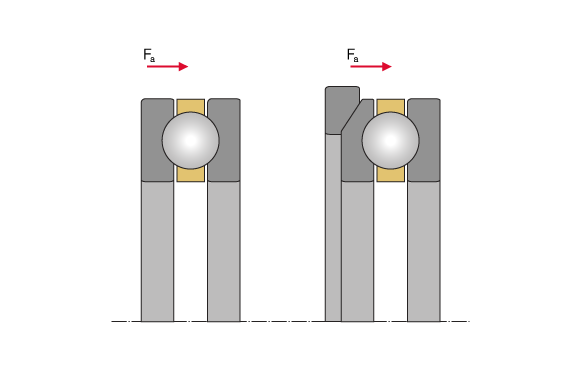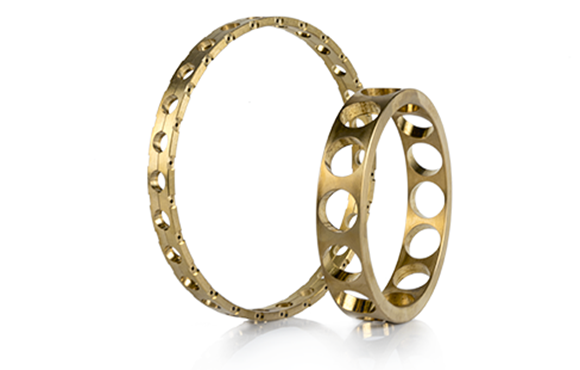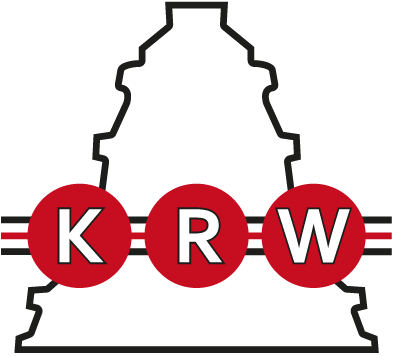
Deep Groove Thrust Ball Bearings
single direction, metric
- Absorption of axial forces from a single side
- Absorption of low radial forces possible
- Supplied with highest precision for machine tools

Single-sided deep groove thrust ball bearings consist of a shaft washer, a housing washer and ball-cage assembly and can absorb high axial forces from one direction while radial loads are not permitted. They are suitable for high speeds and can compensate angular errors and misalignments with a spherical shaft washer and an additional housing washer. Single-sided deep groove thrust ball bearings are not self-latching, so the ball-cage assembly and the bearing washers can be installed separately.
Dimensions and Tolerances
KRW supplies deep groove thrust ball bearings with normal tolerance (PN) in accordance with DIN 620-3 (Tolerances for rolling bearings) and ISO 199 (Thrust bearings - Geometrical product specification (GPS) and tolerance values). All other deviating or special tolerances must be specified with the order.

Bearing Design
Single-sided deep groove thrust ball bearings are non-latching bearings that can be disassembled. They can absorb high axial forces from a single direction while radial loads are to be avoided. To guarantee an accurate centring of the washers, the shaft washer is provided with a smaller sharpened bore. The bore of the housing washer is a little larger and is turned around. In conjunction with a spherical housing washer, the bearing can compensate angular errors and misalignments between shaft and housing.
Bearing Clearance
The bearing clearance for single-sided deep groove thrust ball bearings is adjusted only after installation according to operating conditions. The temperature-dependent length variation of the operating components must be considered.

Cage
By default, KRW deep groove thrust ball bearings are equipped with a solid brass cage (suffix: M). Other cage designs are available on request or chosen for specific applications and labelled accordingly on the bearing.
Suffixes
Compensation of Angular Misalignments
Deep groove thrust ball bearings with smooth housing washer (series 512, 513, 514 resp. 523) are not suitable for compensation of misalignments. Misalignments cause harmful ball movement and produce additional stresses in the bearing which reduce its operating life.
Deep groove thrust ball bearings with spherical housing washer (series 532, 533 resp. 543) are suitable for compensation of misalignments between shaft and housing due to shaft deflections, angular errors and housing deformation.
Speed
The kinematic limiting speed nG is a practical mechanical limit value and is based on the mechanical fatigue strength of the rolling bearing as a function of its installation situation and lubrication. The limit speed must not be exceeded even under optimum operating conditions without prior consultation with KRW.
The DIN ISO 15312 (Rolling bearings - Thermal speed rating) does not specify a thermal speed rating nth for these bearings.
Admissible Operating Temperatures
The admissible operating temperature of a bearing is limited by cage material, dimensional stability of the bearing components (ball race and rolling elements), as well as lubrication. By default, KRW bearings are stabilised up to 200°C (S1). KRW provides roller bearings for higher operating temperatures on request.
Dimensioning
For dynamically loaded bearings
The service life formula according to ISO 281 L10 = (C/P)p for dynamically loaded bearings requires an equivalent load (P) from constant direction and size. To calculate P, calculation factors and the ratio of axial and radial load are required.
Equivalent dynamic bearing load Pa
The equivalent dynamic bearing load can be determined using the following formula:

| Pa | equivalent dynamic load | [kN] |
| Fa | dynamic axial force | [kN] |
For statically loaded bearings
Dynamic dimensioning loses its validity for bearings rotating at very low speeds (n x dm ≤ 4000 mm/min). The static load safety factor S0 is calculated as follows:

| S0 | static load safety factor | [-] |
| C0 | basic static load rating (from bearing chart) | [kN] |
| P0 | equivalent static bearing load | [kN] |
| n | bearing speed | [min-1] |
| dm | mean bearing diameter [dm = (D+d)/2] | [mm] |
Static load capacity

Minimum Axial Load
A minimum load is required for the reliable operation of a rolling bearing. If the minimum load is not reached, slippage may occur. Deep groove thrust ball bearings are protected against slippage exclusively through a minimum axial load. The calculation for the minimum axial load for deep groove thrust ball bearings is shown in the following formula:




